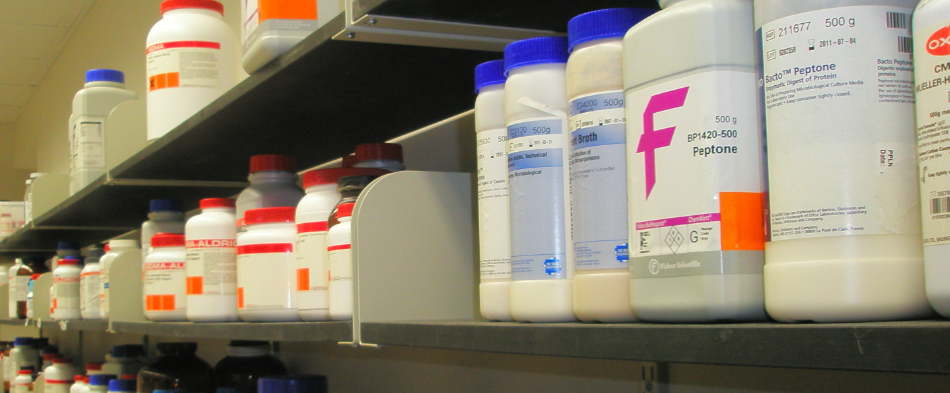Team:Illinois/Bimolecular Fluorescence Biosensor Notebook
From 2008.igem.org
| Home | Team | Project | Notebook | Research Articles | Parts | Protocols | Pictures |
Contents |
1st July
- TE Buffer Recipe
- Uses
- TE used to bring up oligos into solution
- Uses
- People who know how to do this
- Joleen, Luke
- People who know how to do this
- Concentration
- 10mM Tris
- 1mM EDTA
- pH 8.0
- Concentration
- Method
- For 500mL volume
- Add: 0.1861g EDTA; 0.6057g Tris to 1 liter flask
- Bring it up to 500mL with Deionized water (filtered in ---? container)
- Put on "corning" mixer; get a larger stir bar from drawer and put on slow ~20 RPM rotation; no heat for 2-3 minutes until fully dissolved.
- Standardize the pH meter (instructions on sign at prep bench)
- Put gloves on; put pH electrode in flask but first add stir bar and put on low speed mixing
- Bring pH to 8.0 (i.e. 8.00 +/- 0.05) by adding base (NaOH) or acid (HCl) in very small drops using a plastic pipette. (Wait for pH meter to eqiullibrate after each drop)
- For 500mL volume
- Method
IMP: Put cap back on bottom of pH probe
- Put coloured tape along side of flask and label with pH, name and iGEM
- Cover it with heavy duty aluminium foil (just like a square inch to cover the top) and put a strip of autoclave tape along top of foil
- Optional: out in big plastic autoclave bin
- Bring to autoclave room; do not use the big "Beta Star"
Set on: 15 minutes; ~250 degrees Farenheit = ~121 degree Celcius; "liquid" run; for "operator #" just press enter; then "Run"; tubes = ~ 45 minutes; total to run since it must cool down and decompress
- (Some extra side notes still to add)
- TAE Buffer Recipe
- TBE Buffer Recipe
- 1 liter of 5x TBE Running Buffer, pH 8.13-8.23
- Materials
- Tris-base - 54.0g
- Boric Acid - 27.5g
- EDTA - 2.92g
- DI Water - 1.0L
- Materials
- Method
- Stirred with stirring rod for 3-5 minutes
- Method
- Agarose Gel
2nd July
- DNA Sequencing - "Core Sequencing " --?
- (https://unicorm.biotec.uiuc.edu) -> "create login account" -> go to "payment manager"
- Primer: One end primer, included in per tube, 10uM concentration of primer
- 30-40 ng/uL? sample concentration
- Protocols/prep online
- ---? to view chromatograms on site
- $5 for sequencing; $2.50 for "--? to load"
- Purify with PAGE before bringing in
1st July
- PCR Synthesis of BiFC Genes
- from "PCR-based Synthesis of Long DNA Sequences" 2006 Nature Protocols
- Attempted synthesis of Venus Fluorescent Protein halves (N and C term) fused to HIV gp41 epitope
- Formed gene from ~50nt segment oligos at 30uM
- PCR reactions as described in paper; 50uL reaction volume
- 'FivePrime MasterMix' PCR mix
- PCR protocol as in paper for both N terminal
2nd July
- Gel #1: Results from July 1 PCR
- Each lane has 2uL orange/blue loading dye; 1% agarose gel
- Lane 1: Hyperladder II; 2: 8uL C term whole rxn; 3: Cterm w/o leftmost oligo; 4: C w/o rightmost; 5: Just outer oligos 6-9: Same except N terminal fragments
- 60 minutes at 140 V then 10 min in EtBr dye
- No great product
3rd July
- Gel #2: again of July 1 PCR
- all lanes have 2uL Loading dye; 1% agarose gel
- Lanes 1+10=ladder; 2+4=8uL whole N term gene; 6+8=8uL C term gene
- again, very fuzzy, impure product
8th July
- Agarose Gel Purification of Oligos
- Made 4% Agarose gel with 8g Agarose, 40mL TBE, 160mL H2O
- Made 2% with 4g Agarose
- Microwave for 1:35 for optional warming
- Ran total of 2 hours on 80 Volts -> --? (decent?)
- TAZ side project
- Adam Z streaked 4 plates with High Elu, Amp m100, Taz Ecoli
- Check for growth tomorrow
- Gel Extraction Protocol
- Use microscope slide to cut gel out
- Visualize on Bio unit with plastic shield from drawer below unit attached to slide out unit
- Amount of gel collected(into 1.5mL tubes)
- Oligo #2: 0.0671g -> 402.6g
Oligo #3: 0.062g -> 362.0g Oligo #4: 0.1062g -> 637.2g Oligo #5: 0.0747g -> 448.2g Oligo #6: 0.0585g -> 351.0g Oligo #7: 0.0601g -> 360.6g Oligo #8: 0.0440g -> 264.0g Oligo #9: 0.0482g -> 289.2g
9th July
- Cells were found in small colonies -> decided to let them grow for 24 more hours
- Plated 4 more E.coli strains with Xgel (spread)
- Cultured 4 vials of E.coli with X gel
- Check back in 36 hours
9th July
- PCR amplification of July 1 PCR
- Hope to get more product, specifically C terminal half
- half of 50uL of pcr reaction volume obtained as 'oligo mix'
- Tube 1: 25 uL oligo mix +1uL of each outer oligo + 20uL Mango MasterMix
- Tube 2: 3uL of oligos 1-5, plus 20uL MasterMix; 50uL total volume with added water
- Tube 3: 3uL oligos 6-10 plus 20uL MasterMix
9th July
- Gel #4: Analysis of July 9 PCR
- 1% Agarose gel
- Lane 1: Hyperladder II; 3: 8uL C-term protein (tube1); 5: 8uL tube2; 7: 8uL tube3
- Run 50 minutes at 140 Volts
- Again, lackluster: huge streak seen above and below where we expected product
- Try Again
11th July
- Temperature-gradient PCR of Unpurified Oligos
9th July
| Home | Team | Project | Notebook | Research Articles | Parts | Protocols | Pictures |
 "
"
